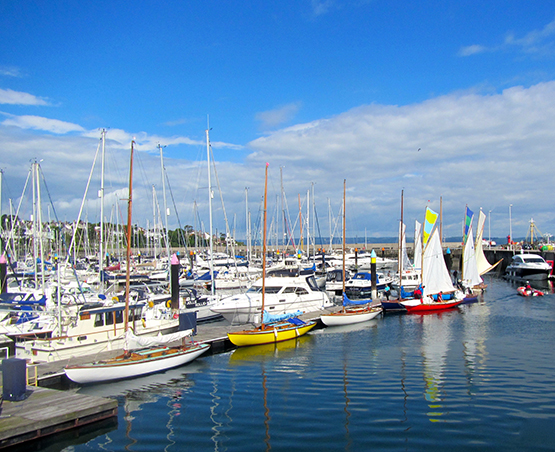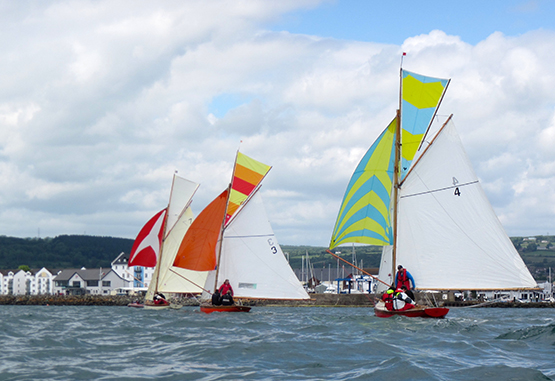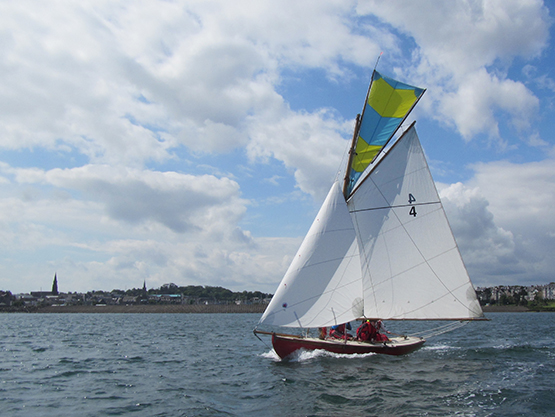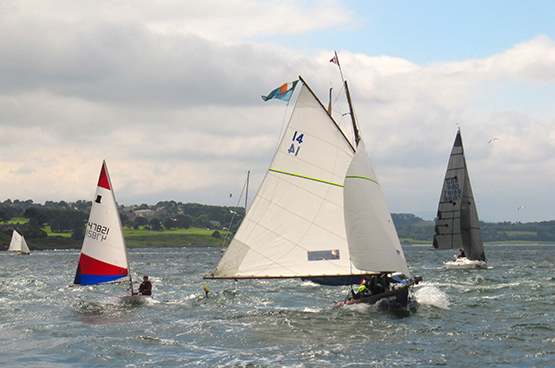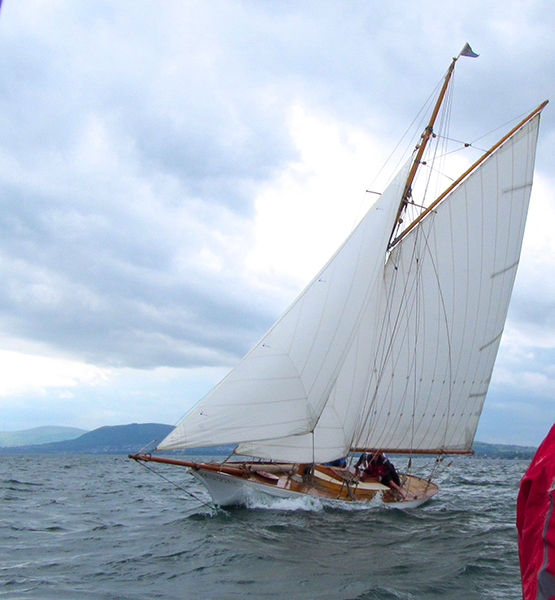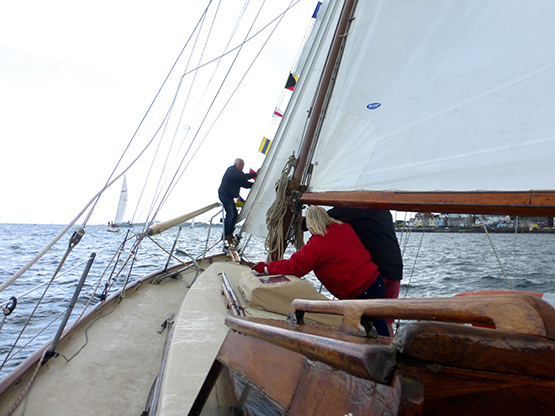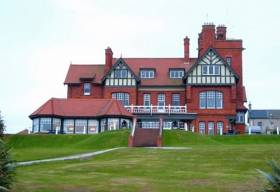Displaying items by tag: RUYC
Afloat.ie’s W M Nixon grabbed only a few hours sleep after his almost continuous coverage of the Volvo Round Ireland Race 2016 before haring off to Bangor in County Down to sail in the RUYC 150th Anniversary Regatta on Saturday June 25th aboard the same boat on which he took part in the same club’s Centenary Regatta in 1966 – and with the same crew. But he arrived at his former home port to find that the defining sailing symbols of his more recent home port of Howth had got there before him…
The amateur yacht designer Walter Boyd of Howth crewed on his father’s 72ft cutter Thalia in the Royal Ulster Yacht Club regatta at Bangor on Belfast Lough in July 1897. A week earlier, the Boyd family had concluded their accumulation of tidy sums in prize money in the Clyde Fortnight with the 1891-vintage Fife-designed Thalia. Ironically, Thalia had been sold away from the Clyde to Judge Boyd of Howth in 1892 at a bargain price, as her original Scottish owners felt she was being out-classed by the new boats from the other Scottish designer, G L Watson. But the Boyd family seemed well able to demonstrate otherwise.
Certainly by 1897 it was Fife who was again in vogue with newer winners like Isolde and Ailsa, and that year saw the advent of the new Fife-designed Belfast Lough One Design Association 25ft LWL Class I boats, built by up-and-coming boatbuilder John Hilditch of Carrickfergus on the north shore of Belfast Lough.
They made a very favourable impression on their debut at Clyde Fortnight in late June and early July 1897 closely observed by, among many others, the Boyd family on Thalia. And after returning to strut their stuff at home at the Royal Ulster regatta in mid-July, four of the BLOD 25s then went on to race for several days in the Dublin Bay regattas, making such a good showing that it inspired the formation of the Dublin Bay 25ft OD Class.
The Dublin boats, with the first appearing in 1898, were of the same hull profile, but with slightly finer sections and built to a much higher specification, with a lead ballast keel as opposed to the Belfast Lough boat’s cheap-and-cheerful cast iron.
Yet even while the pundits of the Clyde, Belfast Lough and Dublin Bay were debating the merits of one against the other, and indeed whether it was even a feasible idea to have a One Design of such a size that she was capable of going offshore, the Howth men returned to their peninsula home, and cogitated among themselves on what they had seen. They were looking for something economical to replace the deathtraps which were the Half Raters they’d been racing for three or four seasons.
Bangor Marina with some of the Mylne-designed Glens from Strangford Lough in the foreground, and jackyard topsails much in evidence on the Howth 17s beyond as they prepare to race across Belfast Lough to their 1898 birthplace of Carrickfergus. Photo: Trish Nixon
The result was that by the end of October 1897, Walter Boyd had produced a design for an able little 17ft LWL, 22.5ft LOA gaff sloop complete with jackyard topsail. An order to build the first five was immediately placed with John Hilditch at Carrickfergus. And by the beginning of April 1898, these new Howth 17s were ready to be sailed the 90 miles to their home port by their notably keen owners. From design finalisation to first race took barely six months, which tells us much about the spirit of the 1890s.
The world has moved on since 1898, but there is still a numerous class of Howth 17s at Howth, including the original five built by John Hilditch at Carrickfergus. In 1998 a flotilla of them returned by road to their birthplace for some decidedly crisp Easter sailing to celebrate their Centenary, and then – the wind being fair – they all made a fast if freezing overnight sailing passage home.
The Return of the Seventeens – approaching Carrickfergus SC on June 23rd 2016, Ian Malcolm’s Hilditch-built Aura (7) leads from Roddy Cooper’s Leila (3, also Hilditch-built) while third lies Class Captain Tom Houlihan in the 1899-built Zaida. Photo: Trish Nixon
Since then, they’ve had further outings to various classic events, with a couple even managing Brest on one occasion, and the Solent Classics on another. But their most impressive outing was in 2003 when no less than 15 boats were moved in a masterclass of logistics to the Glandore Classics. So although the regular annual race programme, which provides them with sixty races each summer at Howth, is the backbone of the class, now and again other possibilities turn up, and for 2016 there was a double offering on Belfast Lough.
There, sailing seems to have suddenly taken off in 1866, as 2016 offered both the 150th Anniversary of Carrickfergus Sailing Club with a special Hilditch Regatta to celebrate the memory of a boatbuilder who was in business for only 24 years from 1889 to 1913, but he was very productive during those years. And it was also the 150th Anniversary – the Sesquicentennial, forsooth – of the Royal Ulster Yacht Club, which had started life as the Ulster Yacht Club in 1866, but thanks to having Lord Dufferin of high latitudes cruising fame as Commodore, by 1869 they’d the Royal warrant.
Yet when the Howth 17s’ designer raced with his father and siblings aboard the Thalia at Bangor in 1897, the RUYC was still modestly housed in a rented semi-detached house – a big semi-detached house admittedly – above the Bangor seafront. So although the Belfast Lough season of 1898 had still not begun when the new Howth 17s sailed past homeward bound in April 1898, there was a flurry of building work under way on the Bangor waterfront, as RUYC had acquired an important new member, and he required the club to have a proper clubhouse to provide a base for a project he had in mind.
First time together – the RNIYC Fairy Class, built by John Hilditch in 1902, get together in Carrickfergus with the Howth 17s (built Hilditch 1898) Photo: Trish Nixon
The new member was Thomas Lipton, already a multi-millionaire with a rapidly expanding grocery empire. His ambition was to challenge for the America’s Cup, and his notions of grandeur chimed well with the feelings of a significant group of the RUYC membership, who felt that a rented semi-detached house, despite its desirable seafront location, was no longer adequate for their rapidly rising status in the world of yachting.
A mid-season meeting of RUYC members in 1897 had already decided that a new clubhouse be built, and architect Vincent Craig – a keen sailing man – soon produced an Arts & Crafts-inspired design with a hint of the Scottish baronial for the selected dominant site. The whole extraordinary confection of a building, with a sort of inspired “instant antiquity” in the mood it created, was built in 18 months, with the opening in April 1899. As we were suggesting earlier, things got done – and done quickly – in Belfast Lough in the 1890s.
The 1899-completed clubhouse of the RUYC was built in a near-record time of 18 months. Photo: W M Nixon
Since then, Thomas Lipton’s five America’s Cup challenges have come and gone, and though he never won, he was definitely a serious contender in 1901 and 1914. World wars have since been fought, empires have disappeared, the global map has changed, and the world structures of sailing have been re-configured. Yet the Royal Ulster YC’s history-laden clubhouse continues to brood above the Bangor waterfront. And the Howth 17s remain unchanged at Howth. They and the RUYC clubhouse are almost exactly the same age. Clearly, the Sesquicentennial Regatta offered a very special opportunity for these two relics of old decency to get together for the very first time.
Of course, there was far more to the events of this past week and more on Belfast Lough than this. But when a 118-year-old class is kept in good order in one place, and a 117-year-old clubhouse of real character is lovingly maintained in another, there’s every possibility of an interesting chemical reaction when the two get together.
But for me, interest in this event was in another direction entirely, for 1966 was the last year in which most of my sailing was Belfast Lough-based. I tended to head south thereafter, soon re-locating in Howth. But for the Centenary Year of 1966, it was Belfast Lough and RUYC virtually all the way, and as on many occasions during the 1960s, there was a June cruise with the chartered 9-ton yawl Ainmara – designed and built by John Kearney of Ringsend in Dublin in 1912 – to West Cork.
It was the first proper sailing visit to West Cork, for though we’d called at Baltimore while coming in from the west coast during an anti-clockwise round Ireland cruise with Ainmara in 1964, for 1966 we lingered on in summer somnolence (remember when summers had somnolence?) in sweet places like Glandore and Castlehaven when they were decidedly less crowded than they are today.
The only time limit on this easy-going venture was to get Ainmara back to Belfast Lough in time for the Centenary Regatta of the RUYC at the end of June 1966, for the old girl (we already thought of her as very old in 1966) had recently passed into the ownership of Dickie Gomes, and as an RUYC member and very proud of his newly-acquired boat, this was definitely a must-do fixture.
The day itself was one of a sunny though not overstrong nor’easterly, but as it would have set up an awkward little popple in the Belfast Lough sea state, Ainmara was not at her best against more modern boats in the windward work. So although there’s a medallion on the bulkhead in Ainmara’s saloon to commemorate her participation in this Centenary Regatta, fifty years later neither Dickie Gomes nor his wife Deirdre nor I – all of us on board at the time – have any idea of our result, but we’re reasonably sure it wasn’t a win, so blessed amnesia has been at work in the intervening fifty years.
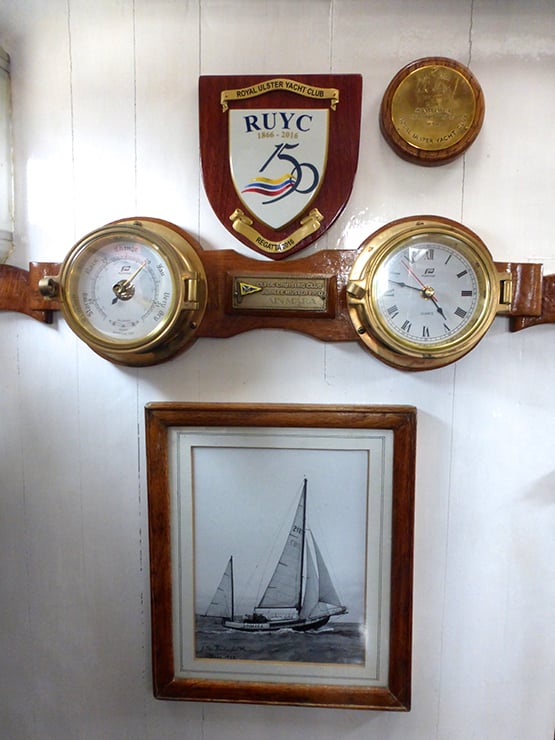
The saloon bulkhead in Ainmara now has the addition of the 150th Anniversary plaque. The medallion top right commemorates the RUYC Centenary Regatta of 1966, between the clock and the barometer is a smaller plaque commemorating participation in the Clyde Cruising Club’s Golden Jubilee Cruise-in-Company in 1969, and the photo is of Ainmara at the start of the CCC’s 1972 race from Inverness across the North Sea to Norway. Photo: W M Nixon
During those same fifty years, while Dickie kept on with Ainmara and did many things with her, including racing to Norway and cruising to the Outer Hebrides and southern Brittany and notching success in many North Channel offshore races, he also spread his wings in many other sailing directions. In 1982 he and sailing friend Brian Law built the 40ft Dick Newick trimaran Downtown Flyer with which they scored a raft of successes in events up to the international Round Britain and Ireland level, and in 1986 – in November, no less - he established a new Round Ireland Record with the 83ft catamaran Novanet. This record stood until Steve Fossett came along to snatch it with the trimaran Lakota in September 1993, and then in 1988 Dickie Gomes found himself back in mono-hulls, in command of Brian Buchanan’s Frers 49 Hesperia (she’s now Jamie Young’s Killary Flyer down in north Connemara), and was overall winner of the 1988 Round Ireland Race.
This successful relationship with Hesperia became a feature of the sailing scene for many years, and during this period Ainmara was resting in a shed at Dickie and Deirdre’s farm in the Ards Peninsula in east County Down, awaiting repairs and refurbishment after breaking from her moorings in Strangford Lough in a winter storm. But she’s a tough old bird, John Kearney built her well, she was well worth restoring, and there was never any doubt that, whatever the other distractions, she’d be sailing again for her own Centenary in 2012.
She was out and about again in 2011, her Centenary in 2012 was then marked with a celebratory cruise to the Outer Hebrides, and in 2013 she played a starring role in the Golden Jubilee Celebrations of the Old Gaffers Association, adorned with prizes too, for although Ainmara has been Bermudan-rigged since the 1930s, she’s revered as an honorary gaffer.
Tom Houlihan’s Howth 17 Zaida off Bangor. Photo: Trish Nixon
The Sesquicentennial Parade of sail was a real floating come-all-ye, with Toppers and other dinghies mixing it with Howth 17s such as the award-wining Gladys (14) and modern cruiser-racers. Photo: Betty Armstrong
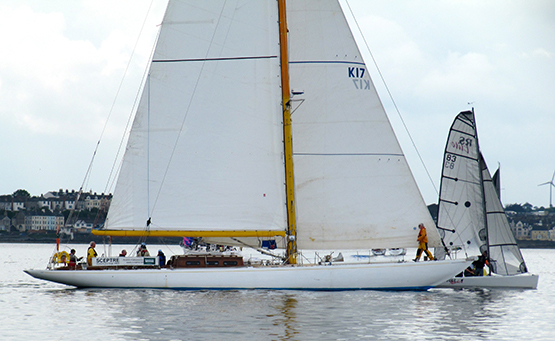
History afloat. The 1958 America’s Cup Challenger Sceptre off Bangor with an RS Elite. There’s more to this than meets the eye – the RS Elite is Phil Morrison’s miniaturized take on the special America’s Cup Class which succeeded the 12 Metres such as Sceptre as the boat of choice in AC racing. Photo: Betty Armstrong
Thus the up-coming RUYC Sesquicentennial Regatta was seen as a celebration of many things, of friendships which have withstood the test of time for many decades, of wonderful old boats which continue to give great sport, and of a surreal clubhouse which had become increasingly irrelevant as sailing’s focus shifted to smaller boats with amateur crews, but then found a new role as a sort of living museum of sailing history when Bangor was provided with what was then Ireland’s largest marina in 1991. This elevated the old clubhouse on the hill into a sort of Temple of Sailing, where devotees of the more rugged versions of the sport can retreat to reflect on their experiences in a peaceful setting well away from the hurly-burly of the marina waterfront.
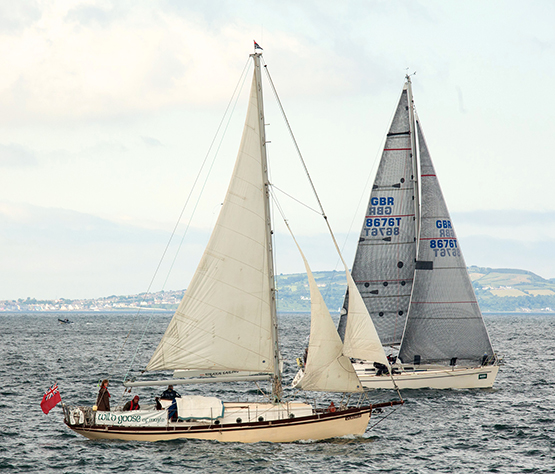
The RUYC Sesquicentennial attracted boats from every background. This is Wild Goose from Portrush, renowned in times past for her links with sailing writer Wallace Clark. She has been complete up-graded in a somewhat changed form by Robin Ruddock of Portrush, who brought her to Bangor to salute 150 years of Belfast Lough sailing. Photo: Andrew Gallagher
So how do you celebrate the 150th Anniversary of such a remarkable institution? It’s of special interest in Ireland, as we are already anticipating the 300th Anniversary of the Royal Cork Yacht Club in 2020. In Bangor, RUYC Vice Commodore Myles Lindsay and Rear Commodore Greg Taylor and their team put together an intensive four week programme which has seen a variety of events including the Sigma 33 Championship, a Classic Yacht Regatta, a 150th Anniversary Regatta which included a wide range of boats reflecting Belfast Lough and Ireland’s sailing’s diversity, while this weekend it is concluding with an assembly of the Cruising Clubs which will mercifully see the focus of activity move gracefully up the west coast of Scotland and into the Hebrides in a Cruise-in-Company which will enable them to pause for breath back in Bangor.
In tandem with this, the Hilditch Regatta at Carrickfergus drew in the Bangor-assembled boats on Thursday June 23rd for a good day of sailing, and for the first time ever it brought the Hilditch-built Howth Seventeens which had breezed in from Bangor together with the Hilditch-built (1902) Fairy Class from the Royal North of Ireland YC across the lough, plus sundry other craft including the Ainmara, without which no proper boat event in the north is complete.
Hal Sisk’s 1894-built Peggy Bawn returns to her birthplace of Carrickfergus in June 2016. Photo: Trish Nixon
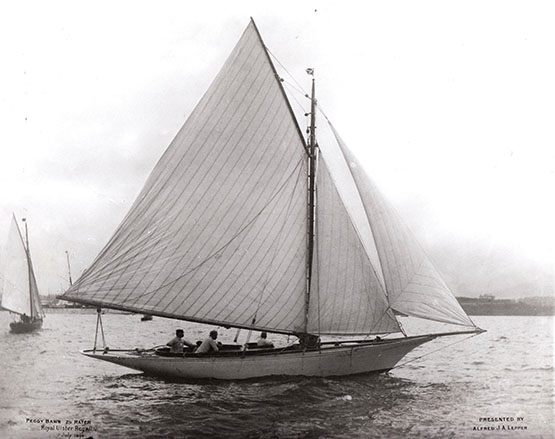
Peggy Bawn on Belfast Lough in 1894. Photo courtesy RUYC
However, by any standards the star of the show was Hal Sisk’s meticulously-restored G L Watson-designed 36ft Dun Laoghaire-based Peggy Bawn, a Hilditch-built cutter of 1894 vintage. While the Howth 17s are still as originally designed, although standards are rising every year they’re not all yet to classic yacht standards. As for the Fairy Class, they have been changed to Bermudan rig. And the old Ainmara and others like her are clearly not as originally designed. But Peggy Bawn is in a league of her own - she’s so authentic and exquisitely finished that it hurts.

Roddy Cooper’s Leila (built 1898) and the RUYC clubhouse (built 1899) get together for the first time. Photo: Betty Armstrong
The Howth Seventeens re-assembled back in Bangor to find they were seven in all, a gathering made easier - when you’ve only four road trailers - by the fact that the father of the class, Nick Massey, crewed by Dave Nixon, had sailed the 1907-built Deilginis from Howth to Bangor in two swift daylight stages, with a stop in Ardglass. They were now joined by six boats of the Glen Class which had sailed round from Strangford Lough, for although the Alfred Mylne-designed 25ft Glens – which originated in 1947 – are now found only in Strangford Lough and Dun Laoghaire, they began life as an RUYC Class, built in Bangor at the long-extinct Glen Boatyard on Smeltmill Bay to the west of the town.
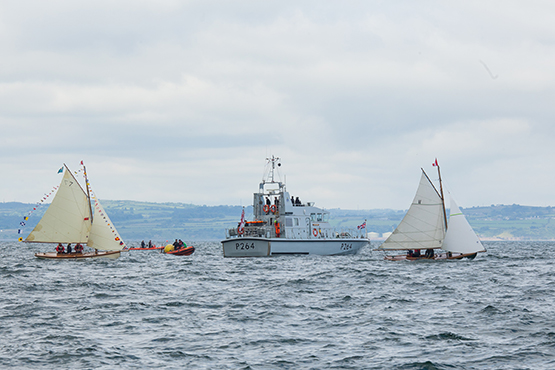
Howth 17 overall winner Aura (Ian Malcolm, left) and Deiliginis, which sailed from Howth to Bangor, parade past the guardship HMS Archer. Photo: Andrew Gallagher
Together with the restored local 18ft keelboats of the 1902 Waverley class in Bangor, there was now a comprehensive gathering of past and present to sail forth in the RUYC Sesquicentennial last Saturday. Your reporter arrived on board Ainmara in reasonable time to find the doughty skipper and his shipmate Brian Law dressing the old boat overall, while just across the pontoon was the 1958 America’s Cup Challenger, the 12 Metre Sceptre, on one of her regular outings from the north of England. And across the way was Dutch skipper Ben Korner’s Open 40 Masai, recently retired from the Volvo Round Ireland Race thanks to a broken forestay fitting, hugely frustrating as they’d been in a splendid battle through the North Channel against RORC Commodore Michael Boyd’s First 44.7 Lisa, which went on to place third overall.
At this stage of the day there still seemed a chance of some lasting sunlight, but as Ireland was plumb under the malign influence jetstream, weatherwise it was a day of everything except what you wanted. But in terms of a reunion it was perfect, as I sailed again with Dickie and Deirdre Gomes, and our crew was joined by Jervis “Jess” Fleming home in holiday from West Australia – last time we sailed together, it was on that early June cruise of 1966 in Ainmara to West Cork.
With winds fluking around between northwest and northeast and sudden gusts coming from everywhere, the water of Belfast Lough were in a horrible popple which was a death knell for Ainmara’s afternoon racing hopes, but first there was the main part of the programme, the Sesquicentennial Parade of Sail, and for that the breeze was in brisk form.
Doughty skipper Dickie Gomes (age undisclosed) takes to the bowsprit to clear Ainmara’s jib topsail, while Deirdre Gomes (back to camera) and Jervis Fleming, both of whom sailed on the boat in 1966, get ready to tail on the halyard. Photo: W M Nixon
In fact, if it hadn’t been a Parade, we wouldn’t have dreamt of sending up our jib topsail. But our doughty skipper – whose chronological age is a secret, he’s permanently 25 in apparent terms – was soon out on the bowsprit clearing it for hoisting, the motley crew got it aloft, and in the nick of time the old girl was roaring along at full chat to cross the line in top style – even her bunting looked its very best.
As for the racing, we had our moments, but were stopped still for too long, while newer boats glided ahead, to figure in any prize-worthy placings. But frustration was soon allayed by a fresh new nor’wester which we enjoyed so much we sailed an entirely superfluous circuit of the course, and then back in the berth the old saloon was so comfortable and filled with memories that we yarned well past the time when we should have been up in the club for the official events. But we touched base there in time for our skipper to get his prize as Best in Show, which was all due to that last-minute full blossoming of the jib topsail just as the old girl came roaring up to the parade area inside the Royal Navy’s HMS Archer.
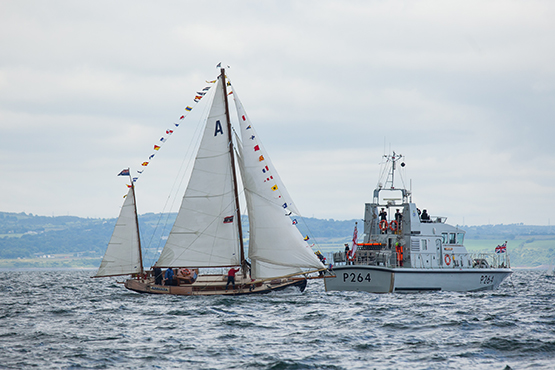
Made it in the nick of time……Everything up and drawing as Ainmara sweeps past the Guardship. Photo: Andrew Gallagher
The Howth 17 crews were made welcome and made themselves very much at home in the RUYC clubhouse. Photo: W M Nixon
So fifty years after the Centenary Regatta, Ainmara’s participation in the RUYC Sesquicentennial Regatta had hit the jackpot. The high was maintained all evening amidst much banter from the Howth 17 crowd, who had made themselves thoroughly at home in RUYC, with Ian Malcolm’s Hilditch-built Aura reckoned the best performer, though the 1907-built Gladys (Pat Heydon, Ian Byrne and Eddy Ferris) got the award for best-dressed overall. As Ian Byrne revealed, they’d gone to the trouble of putting their signal flags in the approved naval order, and these things count when you’re celebrating a 150th birthday.
The One-Designs had another day’s racing on the Sunday, but our job was done, and we’d to get Ainmara home to her secret place among the islands of Strangford Lough. As all the Howth 17s were going to be road-trailed home, Paddy Cronin with the 36ft Westerly Conway Aquarius of Howth was no longer needed as mother-ship, so we were his pilot veseel in an effortless if damp passage down the County Down coast, through Strangford Narows with the surging flood tide, and on along a winding route to Ballydorn, where the snuggest of berths was shared at the pontoon at Down Cruising Club’s lightship headquarters. It was a good end to some very special days.
The weekend comes to a close in a very special place. Ainmara with Aquarius of Howth berthed alongside the Down Cruising Club’s pontoon at its lightship headquarters at Ballydorn in Strangford Lough. Photo: W M Nixon
Royal Ulster Yacht Club's Sesquicentennial Regatta Weekend
At Royal Ulster Yacht Club over 80 boats gathered off Bangor on Saturday to take part in the 150th Anniversary Sail Past.
It was the latest event in June's RUYC Sesquicentennial celebrations. Previously, as Afloat.ie reported, the club welcomed HRH The Princess Royal to the Club. The occasion was a lunch in conjunction with the Royal Yachting Association of which Princess Anne is President.
150th celebrations got underway on June 20th when the club staged the British Sigma 33 Britsh and Irish Championships.
The sail past was presided over by Mr David Lindsay, Lord Lieutenant of Down with all the yachts sailing or motoring past the Club between the shore and HMS Archer. Nearly every yacht, motorboat and dinghy was dressed overall to make the occasion colourful. There were some outstanding sights such as Dickie Gomes' Ain Mara under sail and fully dressed overall who won the prize for Best Dressed large boat. The fleet of Glen Class yachts from Strangford Lough Yacht Club, returning to Bangor where they were built over fifty years ago. Seven members of the Howth 17 one-design class from Howth attended - these boats were originally built in 1897. Howth 17 No 14, Gladys won Best Dressed Overall Small Boat.
The 150th Anniversary Templeton Robinson Regatta followed the Sail Past with the boats competing over a course from Ballyholme Bay towards the Harbour. Mixed wind patterns made for difficult racing for some but everyone did enjoy the special day on the water.
Class Winners:
Class 1 - Mini Mumm - Flannigan Family RUYC/BYC
Class 2 - Bad - Steve Atkinson - CSC
RS Elites - Storm - Messrs Gunning, Kelso and McKee RUYC
Class 4 - Mingulay - Ritchie Family RUYC
Class 5 - Hecla - K Walsh -CIBC/DSC
Class 6 - Wild Goose II - A Armour - CIBC
Glens - Glen Lark - R Aiken - SLYC
Howth 17s - Aura - A Foster - Howth YC
Class 10 - Oliver Haig - Topper
Class 12 - Robert Milligan - RS200
Class 13 - N Strain - RS400
Royal Ulster Yacht Club – 150 Years of Sailing Excellence
The first event of the 150th Anniversary celebrations for Royal Ulster Yacht Club at Bangor on Belfast Lough will take place from Friday 17th to Sunday 19th June. The Sigma 33 UK & Irish National Championships has attracted twenty boats from throughout the UK and Ireland. From Lough Swilly to Waterford, and from the Clyde to Falmouth taking in Liverpool and the Isle of Man on the way. The visitors will join the local boats for three days of racing on the open waters of Belfast Lough.
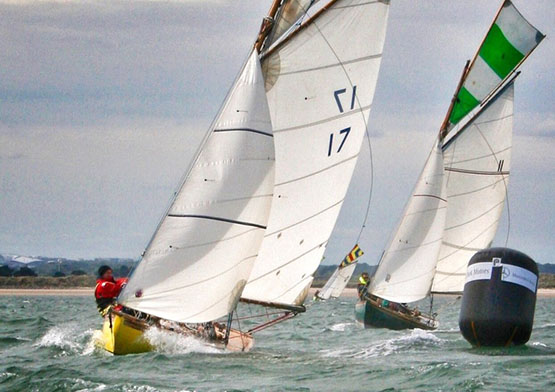
The Howth 17s – the first five of which were built on Belfast Lough in 1898 – will be travelling north to join the RUYC Classics Regatta from June 24th to 26th
Randox Health are also the title sponsor of our 150th Keelboat event with racing between Friday 24th and Sunday 25th June. This event has attracted not only local modern yachts but also some of the classics of the sport such as the Howth 17 Class from Howth, Dickie Gomes’ 103 year old yawl ‘Ain Mara’ which also took part in the RUYC Centenary Regatta back in 1966 , the G L Watson-designed Peggy Bawn, owned by Hal Sisk of Dun Laoghaire and built by John Hilditch of Carrickfergus in 1894, Ian Terreblanch’s ‘Trasnagh’ a 1913 Mylne-designed Island Class yawl also built by Hilditch, and the 1958 America’s Cup Challenger, the 12 Metre Sceptre.

Dickie Gomes’ 103-year old Ainmara will be taking part. She also raced in the RUYC Centenary regatta of 1966
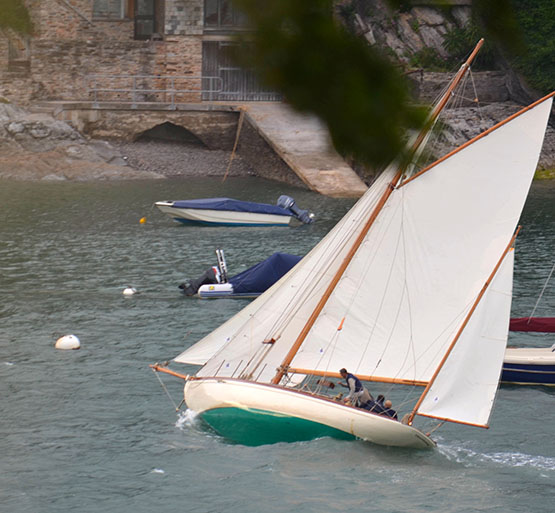
Ian Terreblanch’s 39ft gaff yawl Transnagh will be travelling north from Dartmouth in Devon to join the RUYC festivities. Originally she was built by John Hilditch of Carrickfergus in 1913 to be one of the Belfast Lough Island Class yawls

Hal Sisk’s G L Watson-designed Peggy Bawn – built by John Hilditch in 1894 – was a member of the RUYC fleet from 1898 to 1919
It is hoped to also have the Classic Mylne-designed River and Glen Classes from Strangford Lough Yacht Club also competing, as both these boats started their racing careers at Royal Ulster YC, together with other classics and Old Gaffers which are taking part in the Hilditch Regatta across the lough at Carrickfergus, but are shaping their course for Bangor on the Saturday (June 25th) when a highlight of the three day RUYC Regatta will be a Parade of Sail past the historic clubhouse from where Sir Thomas Lipton made his five Americas Cup challenges – all with racing yachts named Shamrock - between 1899 and 1930. The Sail Past will commence at 12.00 and will be followed by the Club’s Annual Regatta supported by Templeton Robinson.
The fortnight of celebrations – with Randox Health on board as title sponsor of the event – concludes on Friday 1st July with a Gala Dinner, following which a large gathering of cruising yachts which will have assembled in Bangor will be making their final preparations to depart on a 150th Anniversary Cruise-in-Company to the West Coast of Scotland jointly involving boats of the Clyde Cruising Club, the Irish Cruising Club, and the Royal Ulster Yacht Club.

The Royal Ulster YC clubhouse at Bangor
Belfast Lough Sailing Story Seen In A New Light After Princess Anne Gives Royal Lead
Maybe it’s time and more to see sailing and its story – and particularly the complex history of Irish sailing north and south – in a new light. This year, the historical sailing focus is on Northern Ireland, where the Royal Ulster Yacht Club and Carrickfergus Sailing Club are both celebrating their 150th Anniversaries. For RUYC, this has already resulted in a Royal visit in recent days. But it was a Royal visit with a difference. W M Nixon takes a look at how the sailing celebration scene in Northern Ireland is reflecting an increasingly nuanced interaction with our sailing history, and how this in turn can affect how we interpret the story of sailing.
It was certainly a Royal visit with a difference, as it usually is with Princess Anne. Whatever your views on Royalty in any of its manifestations, purposes and functions, it has to be accepted that this is one very hard-working member of the British Royal family. When she’s President or Patron of some national or international organisation, it will almost inevitably be because she’s personally interested in the activities involved. And being an involved and can-do person, rather than a stand-aloof sort of figurehead, you’ll find that she was, and probably still is, a very enthusiastic participant in at least some specialized activity within the broad spectrum of the organisation’s remit.
Thus the fact that she and her husband are keen cruising enthusiasts who have in recent years moved up to the Rustler 44 Ballochbuie – which they base in Scotland - after many years with a Rustler 36, means that her role as President of the Royal Yachting Association is something with real meaning. When she goes to a yacht or sailing club, while inevitably there’ll be that slightly giddy mood which always accompanies the presence of Royalty, there’s no escaping the fact that this is a working visit. It’s a long way from being purely ceremonial – people find themselves talking about their own sailing, and sailing in general, both how it is run, and where it is going.
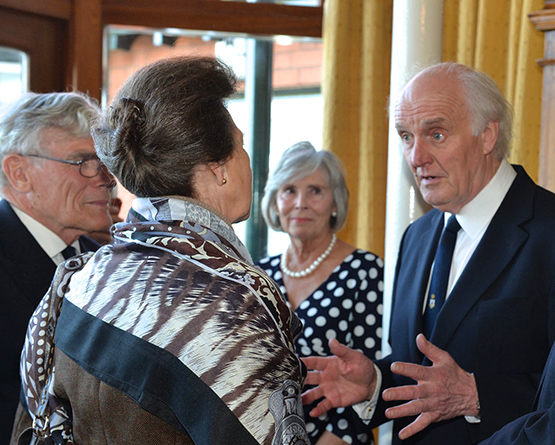
Serious business. Princess Anne in earnest discussion with Gordon Finlay, RUYC Honorary Archivist. On the left is Peter Ronaldson, former Vice Commodore RUYC and former Commodore Irish Cruising Club.
This isn’t the first time in Ireland north and south that Irish sailing has experienced the inspirational results of involvement by the Princess Royal. Twelve years ago, early in 2004, Afloat and the ISA got the word that a Big Idea floated some time earlier might just have wings.
In those days, our annual “Sailor of the Year” and “Sailors of the Month” awards were on a much more commercial basis, as they were strongly sponsored by Cork Dry Gin. It may now seem light years away, that a drinks company could so publically sponsor a major sports awards ceremony. But such was the case – they’d been doing it since 1996.
By 2004 it had become a very smoothly-organised affair, staged in the Irish Distillers Jameson Centre in Dublin where they even have a usefully-sized theatre/cinema which was ideal for this ceremony, and very efficiently organized as an event with Deirdre Farrrell, Irish Distillers’ in-house PR person, skillfully pulling it all together. Afloat and the Irish Sailing Association provided the details on who got what in the awards area, and Paddy Boyd, Secretary General of the ISA, performed as an extremely competent Master of Ceremonies while my job in concert with David O’Brien was to enumerate each of the citations for the usual multiplicity of awardees.
Thanks to the enthusiastic and directly-involved support of the sponsors, this annual show became such a byword for a well-run and popular yet efficiently-controlled event that we found ourselves playing a role in the much wider national and international scene.
The often difficult relations between the Republic of Ireland and Britain had started to thaw quite markedly after the Good Friday Agreement of 1998, and it was obvious that for this normalization process to continue to develop in a meaningful way which would have a resonance for many points of view within Ireland, in due course a Royal Visit to Ireland by the Queen would have to be on the cards.
So the buildup towards such a visit was set in place with quiet appearances at some relatively low key events – international charities were very useful for this – by some minor members of the Royal Family. The process then moved on, and when someone in the ISA/Afloat setup suggested that in order to add that extra zing to the annual Irish sailing awards, we should ask the Princess Royal in her capacity as President of the UK’s Royal yachting Association to do the honours, ISA President John Crebbin and Paddy Boyd made a discreet enquiry to the British Embassy, and found they were pushing at an open door.
Irish sailing’s idea fitted in very neatly with the development and implementation of improvements in Anglo-Irish relations. In a remarkably short space of time, what had been shaping up as the usual awards ceremony at Irish Distillers in February 2004, to present the gongs for 2003 including Sailor of the Year, had been re-shaped as a Royal occasion, while retaining the basics of the proven annual ceremony to provide an event in which everyone could feel at ease.
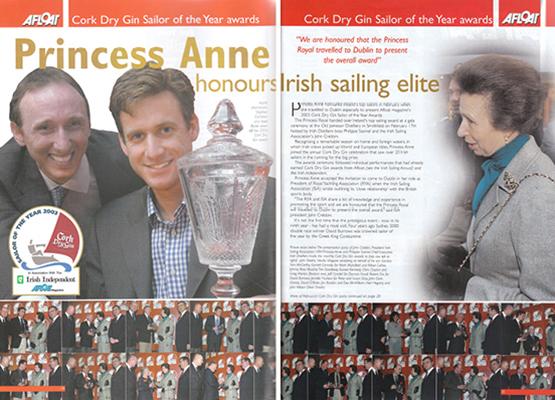
Back in February 2004, Irish sailing was given the Royal treatment in Dublin
For that’s what happened. It all went as smooth as clockwork. Deirdre Farrell was in her element keeping it all nicely but gently under control, while Paddy Boyd’s outlining of Royal protoocal beforehand, and his smooth running of the on-stage happenings, would have made you think he had a second life as some sort of big cheese in the United Nations.
As our double-page spread from the March 2004 Afloat suggests, just about everyone was there, they all had their chance of a word or two – and sometimes many – with the Royal President of the RYA, and then we had to canter through a multiplicity of awards with more appropriate words on stage at each juncture, followed by the presentation of the top trophy, which for 2003 was a double, as it was for Noel Butler and Stephen Campion, new World Champions of the International Laser 2 Class.
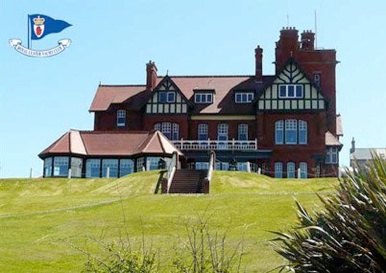
The RUYC clubhouse was built in 18 months in 1898-1899
The Princess Royal’s visit this past week to the Royal Ulster clubhouse in Bangor was a very different affair, as she was honouring the clubhouse as much as the club and the history to which it is home. In fact, the RUYC carries so much history that you’d wonder they aren’t burdened with it. But they wear their sometimes colourful past remarkable past lightly, for the creation in Bangor, over an ongoing process since 1984, of one of Ireland’s largest marinas, with all amenities including a boatyard, has meant that Belfast Lough and in particular Bangor sailing can move confidently through the present and on into the future, as dinghy sailors’ needs are superbly met by Ballyholme Yacht Club on the most easterly of Bangor’s notable bays.
This means that while today’s Bangor sailors can see the two clubs of RUYC and BYC as the natural focal points which meet their contemporary social needs, in the case of the RUYC clubhouse, it can double as a really remarkable sailing museum. Among other things, it includes the Lipton Room, filled with fascinating memorabilia of the hyper-energetic millionaire Thomas Lipton, who made no less than five challenges for the America’s Cup through the RUYC between 1899 and 1930.
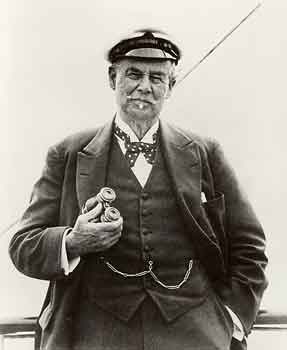
The eternal challenger – Thomas Lipton campaigned for the America;s Cup five times through the RUYC between 1899 and 1930
For the Royal sailing visitor, study time in the Lipton Room provided a vivid insight into one aspect of RUYC history. But then, after the meeting and greeting session with a diversity of members including RUYC Archivist Gordon Finlay and RUYC Historian Ed Wheeler, who are battling with a mountain of incredible material, the visit to the club was rounded out by the presentation to the Princess Royal by Vice Commodore Myles Lindsay of a legendary cruising book which she assured everyone will be going straight into the bookshelf aboard Ballochbuie.
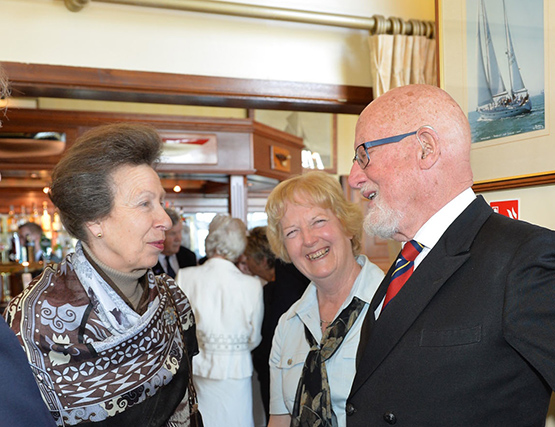
RUYC Historian Ed Wheeler with his wife Jan in a lighter moment with the Royal visitor
The immediately-cherished book was Letters from High Latitudes, published in 1856 as an account of the voyage by Lord Dufferin (his family seat is Clandeboye near Bangor) to Iceland, Jan Mayen and Spitzbergen in the schooner Foam. It has long been a classic of cruising literature, and it still reads today as crisply as though it was written only last week. For Frederick Temple-Hamilton-Blackwood (1826-1902), who eventually became the Marquess of Dufferin & Ava, was a very able sailor and navigator in addition to being a noted diplomat and imperial administrator and excellent raconteur..
So when a few Belfast Lough sailors got together to form the Ulster Yacht Club in 1866, naturally they asked the local national sailing celebrity, this special man who had voyaged to Iceland and beyond ten years earlier, to become its first Commodore, and he in turn ensured that the new club of which he was senior officer became the Royal Ulster YC in 1869.

Lord Dufferin’s Foam, which he sailed to the High Arctic in 1856. He was Commodore RUYC 1866 to 1902.
At first they did without a clubhouse as the sought to serve all the more significant sailors throughout the north of Ireland. But by 1872 they rented some premises on Bangor seafront, and then in 1876 they took a lease on a substantial if semi-detached house on an eminence above the eastern side of Bangor Bay.
By the late 1880s and early 1890s, sailing in Belfast Lough was beginning to take off with local confidence, for before that leading northern sailors such as Henry Crawford with the cruiser-racing yawl Nixie, and John Mullholland - later Lord Dunleath - with the schooner Egeria, had tended to cut a dash elsewhere, Crawford on Dublin Bay, and Mulholland also on Dublin Bay, but even more so in the Solent.
However, by 1890, things were changing very rapidly to bring Belfast and Belfast Lough to the forefront of sailing, and this year’s 150th Celebrations at both Carrickfergus and Bangor – the official title is “Sesquicentennial”, since you ask – make us want to know more.
We’re going through such a plethora of major anniversaries these days – both national and international – that it’s natural there should be growing public interest in the story behind the story, the in-depth background to the history. We now want to know more about some great event way beyond the fact that it merely happened at a certain date, and that by doing so it had some significant outcome.
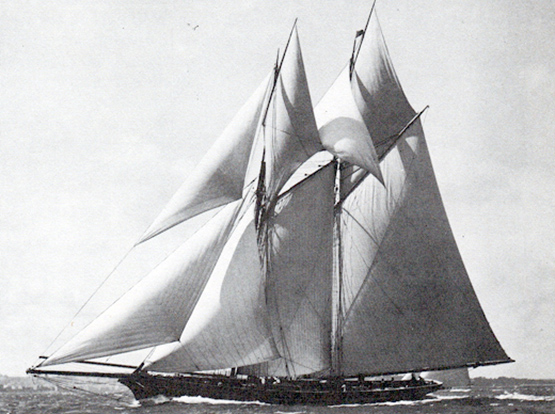
The much-travelled and very successful racing schooner Egeria was built in 1865 for John Mulholland. The following year, he became the first Vice Commodore of Royal Ulster YC
It may well be that one of the reasons sailing is a sport which is lacking in general public resonance is because histories of sailing have tended to concentrate on the narrow narrative of the development of the sport, and the boats it inspires. As for information on the sport’s administrative history, this tends to be no more than closely focused accounts of how clubs and national organisations emerged to meet the growing demands of this new recreational activity, without setting such developments in a broader framework.
Of course, there are many people who go sailing simply to “get away from it all”, for it’s an activity so different from shore life that the mere fact of being on a boat which is sailing is to be conveyed into another world. Such people may well prefer that the history of their beloved escapist sport is kept aloof from the socioeconomic circumstances in which it exists, and the context in which it developed.
But for others, it enriches our experience of sailing to know how it came to be as it is today, and this year in Northern Ireland there are sailing events and commemorations taking place which, when their back-story is analysed in some depth, give us a much better understanding of the way we live today, and how we go afloat today, and it is in turn all set in a meaningful way in the context of the general historical narrative.
In the case of Belfast in 1890, it was suddenly becoming the Mumbai of its day. It may have been the most air-polluted industrial city in the world, but my word they didn’t linger when doing things, as they had the world’s biggest shipyard, the world’s biggest engineering works, the world’s biggest ropeworks, and the world’s biggest linen mills.
It was the sort of place where a bright and energetic young man with some innovative idea in manufacture could make a fortune well within ten years. Indeed, if you weren’t clearly cutting the mustard within two to three years, it was thought you weren’t really in competition at all.
Yet all this was happening in a rapidly-expanding place which had only been accorded city status as recently as 1886, and its famous new-Classical City Hall, the building which still best symbolizes Belfast’s self-image today, was not completed until 1906.
However, all this growth and wealth-creation was taking place in a city which was dominated by the Presbyterian ethos, which had in effect become the northern “state religion” after the Anglican Church of Ireland was disestablished in 1869.
This meant that while there was wealth about, extravagant expenditure on personal enjoyment was frowned upon, and this extended to sailing as to most other things. But the rapidly-rising Belfast area’s middle classes soon found a way of minimizing expenditure while maximizing their yachts sizes and sailing sport.
Some time in 1895, the Belfast Lough One Design Association came into being. Its membership was open to members of any of the half dozen or so clubs now dotted around the lough including the RUYC itself, and its objective was the simple one of creating economical yet effective one design keelboat classes suitable for the sometimes quite demanding conditions to be found in Belfast Lough.
The pioneers of the BLODA persuaded the great Scottish designer William Fife to create them a sweet but able little 15ftLWL keelboat, just 23ft LOA, for 1896, when the first three were racing. And by that time, the Association had become much more clearly structured, as its Honorary Secretary was one James Craig Jnr, aged only 25 but already noted as a formidable organiser.
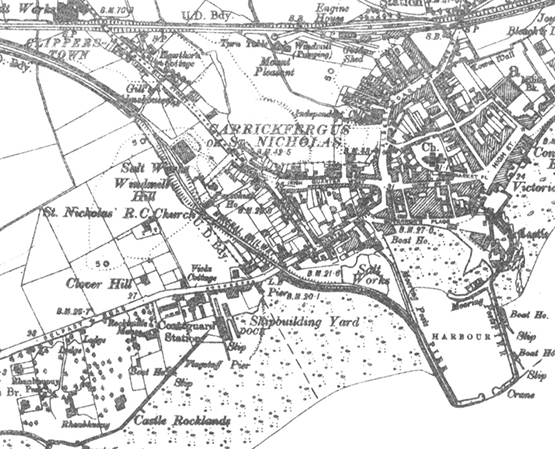
Carrickfergus around 1901. John Hilditch’s first boatyard in 1889 was in the inner harbour where it says “Boat Shed”, then in 1902 he moved to the former shipyard of Paul Rodgers immediately west of the harbour. At the time, Carrickfergus Amateur Rowing & Sailng Club (founded 1866) was in premises on the east side of the East Pier, the more northerly of the two Boat Houses.
In later life he would become Lord Craigavon, first Prime Minister of Northern Ireland in 1921. But in 1896 his prime interest was in expanding the 15ft LWL class with an up-and-coming new boatbuilder, John Hilditch of Carrickfergus. Hilditch was very much in Craig’s sights as the approved builder, as he and his men had already shown with the building of the 35ft G L Watson-designed cutter Peggy Bawn in 1894 that he could stick rigidly to the designer’s drawings, whereas Paddy McKeown, the back-street boatbuilder in Belfast who built the first three 15ft LWL boats, was notorious for always trying to improve on the designer’s original ideas.
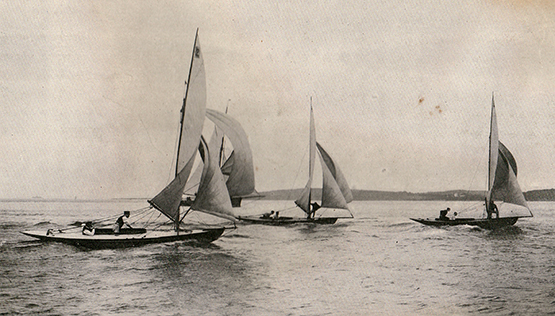
The true pioneers. The Fife-designed 15ft Belfast Lough ODs of 1896 showed the way for the 25ft LWL Class I boats in 1897.
But in the fast-moving world of Belfast in the mid-1890s. events overtook them. Several of the more affluent Belfast Lough yachtsmen had already noted with approval the able seagoing power and attractive performance of the first three 15ft LWL boats. In effect, Belfast Lough provided them with a perfect test tank, and the 15ft LWL boats were their “test models”. In a very short space of time, the heavy hitters in the BLODA had persuaded the Association to order the plans of a 37.5ft LOA, 25ft LWL boats, and thanks to the efficiency of the Hilditch Yachtyard – which in those days was only a few sheds at the head of Carrickfergus Harbour - the first eight boats of the BLOD Class I were racing. They made a huge impact in a visit to the Firth of Clyde in 1897, they went to Dublin Bay where they inspired the creation the following year of the DBSC 25ft OD, and even though at season’s end, when the weekly magazine Yachting World - in reviewing their success - described them as “a cheap knockabout class”, a laudatory report in the influential New York Times of their doings at Clyde Fortnight in Scotland was to carry them through with fresh confidence into their greatest year, 1898.
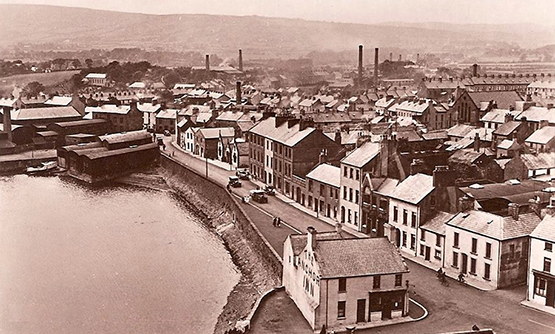
The humble birthplace. The new BLOD Class I boats were built with remarkable efficiency by John Hlditch and his team in the little boatyard in those black sheds on the inner corner of Carrickcfergus Harbour in the wintyer of 1896-97.

In all their glory. The BLOD Class I boats racing in full strength in 1898.
But anyone who is into Centenaries will realise that Belfast in 1898 had become a very different place from Belfast in 1798. In 1798, Belfast had been a hotbed of the United Irishmen, and one of the local leaders in The Rising, the Presbyterian Henry Joy McCracken, had been hanged with The Rising’s suppression, executed in the town centre on public land which had been donated to the citizens of Belfast by his own grandfather.
In addition to his many other interests, McCracken had been a very early pioneer in developing Belfast Lough sailing, and he and his friends cruised most summers to the west coast of Scotland. But while McCracken may have been taken, his friends lived on in an increasingly different Belfast in the early 1800s, where successful trade and manufacturing industry obliterated any earlier political idealism. Nevertheless some of those former shipmates of Henry Joy McCracken formed the Northern Yacht Club on Belfast Lough in 1820. But as Belfast port became ever more industrialised, they found it more congenial to sail on the Firth of Clyde, within a few years there was a Scottish branch, and by 1838 the Royal Northern Yacht Club of Rothesay had completely absorbed its Belfast unit, and there wasn’t to be another yacht club on Belfast Lough until Holywood yacht Club came into being beside its drying anchorage at the little County Down town immediately east of Belfast in 1862.
By the end of the 1860s, the Holywood club had been joined by the clubs at Carrickfergus and the Royal Ulster, but some years were to pass before the sport of sailing came central stage. Yet by 1898, Belfast Lough sailing wasn’t just centre stage on Befast Lough. It was world-leading. The Fife-designed One Design classes were widely admired at a time when Fife’s star was very much in the ascendant, and then in August 1898, Thomas Lipton announced his first challenge for the America’s Cup through RUYC, the actual contest to take place in New York harbour early in October 1899.
Already, there was a movement among members to build a proper trophy clubhouse for the RUYC, and Lipton made it clear he was unenthusiastic about having his challenge based on a club which was head-quartered in a semi-detached suburban house. But James Craig had a talented older brother who was an architect, Vincent Craig, and he soon had the plans drawn up for an arts & craft building which continues to dominate the Bangor waterfront today, and houses a priceless collection of yachting memorabilia, while at the same providing a convivial venue to celebrate an important Sesquicentennal.

Thomas Lipton’s Shamrock IV of 1914 was one of his most promising challengers. But the outbreak of the Great War signalled the end of the Golden Era, and though Shamrock IV finally challenged unsuccessfuly in 1920, in was in very subdued circumstances.
Today, we know that none of Lipton’s Americas Cup campaigns succeeded, though some came tantalisingly close to success. Today, we know that John Hilditch’s wonderful boatyard only lasted for 24 years, and the poor man, worn down by overwork and finacial stress, died on Christmas Eve 1913. And today we know that, regardless of the turmoil within Ireland from 1912 to 1922, it was the Great War of 1914-1918 which was to wipe out the cream of an entire generation from the north of Ireland, with sports like sailing taking a very long time to recover, if they ever really did recover until much more modern times.
Yet in 1898, it was a time of such hope, such anticipation, such planning – such excitement and exuberance. It can all be captured again with the many events at Royal Ulster and Carrickfergus this summer, when in addition to the clubs’ 150th anniversaries, they’re also staging a Hilditch Regatta at Carrickfergus with a Parade of Sail to Bangor to give proper prominence to the memory of a man who contributed so much to the success of Belfast Lough sailing in the Golden Era of 1894 to 1914.
Royal Ulster Yacht Club Celebrates 150 Years of Sailing
In 2016, Royal Ulster Yacht Club is celebrating the 150th Anniversary of its formation in 1866. To mark the anniversary there will be a series of sailing and cruising events throughout the summer.
The important date was highlighted by WM Nixon last Saturday in his Afloat blog Belfast Lough Celebrates 150 Years of Organised Sailing in Style
The main focus of the year’s celebrations is around the end of June starting with the UK and Ireland National Championships of the Sigma 33 Class of yachts (17th-19th June). This event will attract sailors from around Ireland, Scotland, Isle of Man and North West England and Wales.
The following weekend the Club is running its Annual Regatta along with a Keelboat Weekend Event. The Annual Regatta is the flagship event in the club’s year and this year it will include visiting boats from Scotland, Dublin Bay and Strangford Lough to race alongside the competitors from the other yacht clubs in Belfast Lough. The day will start with a Sail Past in front of the Clubhouse and a naval Guardship will be in attendance. The visiting boats will include modern racing craft and classic boats such as the River and Glen classes from Strangford Lough some of which started life competing at Royal Ulster YC over 90 years ago. We are also expecting that several of the classic Howth 17 classes will travel north for our event.
The cruising fleet will be joining forces with similar associations such as the Irish Cruising Club and the Clyde Cruising Club for a social gathering before a cruise-in-company to Scottish waters.
The social highlight of the celebrations will be a Black Tie Gala Dinner at the Club on 1st July.




























